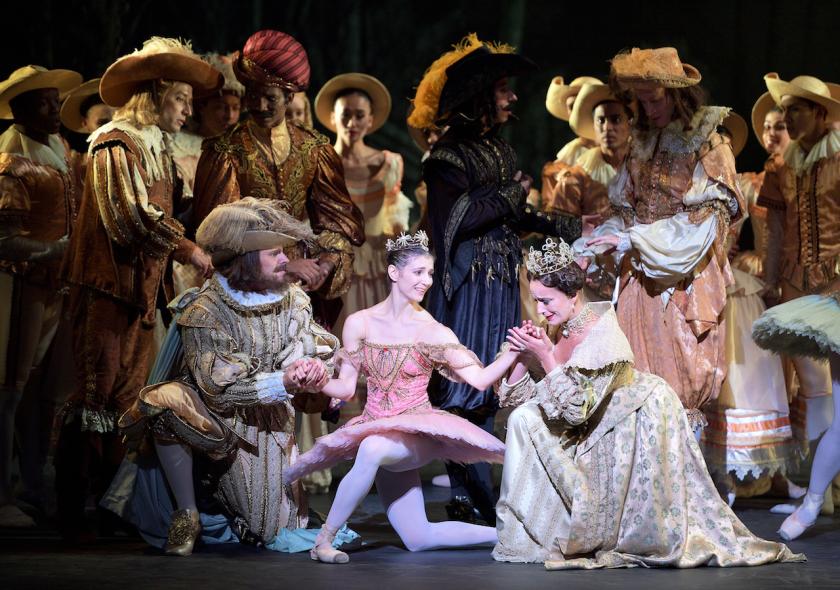When Tamara Rojo won the top job at English National Ballet in 2012, it looked like a poisoned chalice. Directors had come and gone, some of them with visionary ideas, but all were defeated by the company’s peculiar position as underdog to the company at Covent Garden. With a much lower public subsidy and an obligation to tour, ENB has had to overwork box-office certainties such as the annual Nutcracker to stay afloat. An even tougher inheritance for Rojo was the perception that the level of dancing – with some shining individual exceptions – wasn’t quite up to scratch. Well, it is now.
Of all the Tchaikovsky ballets, perhaps of all ballets, The Sleeping Beauty is the greatest test of a company’s classical technique, demanding power and precision in depth from every rank, from the soaring, flutter-toed Bluebird to the comical trio of knitting women forced to surrender their needles, from every cavalier of every solo fairy, even from Red Riding Hood in her flighty cameo towards the end. On a stylistic level alone, this revival of Kenneth MacMillan’s lovingly traditional 1986 production cements Rojo’s achievement. I don’t think I’ve ever seen a more pliant torso or more gracious port de bras than that of Shiori Kase’s Lilac Fairy, bringer of light in the fable’s battle with the forces of darkness. She is spell-binding in the most literal sense.
 You don’t have to like fairytales to enjoy this ballet. MacMillan famously didn’t, but he recognised the usefulness of the story as a grand shop window for everything classical dance can be. His version sticks closely to the notation smuggled out of Russia after the Revolution, which means it’s as close as it’s possible to get to the original 1890 choreography of Marius Petipa. MacMillan’s chief contribution is the Garland Waltz (lovely). Otherwise his presence is felt in the overall dramatic impetus (there’s never a dull moment), and in his choice of regular collaborator Nicholas Georgiadis as costume designer.
You don’t have to like fairytales to enjoy this ballet. MacMillan famously didn’t, but he recognised the usefulness of the story as a grand shop window for everything classical dance can be. His version sticks closely to the notation smuggled out of Russia after the Revolution, which means it’s as close as it’s possible to get to the original 1890 choreography of Marius Petipa. MacMillan’s chief contribution is the Garland Waltz (lovely). Otherwise his presence is felt in the overall dramatic impetus (there’s never a dull moment), and in his choice of regular collaborator Nicholas Georgiadis as costume designer.
The clothes in this Beauty, based on paintings by Van Dyke and (after the hundred-year sleep) Tiepolo, could have a review of their own, yet it’s to the credit of the dancers that the costumes never wear them. The panniered skirts that bloom into fuchsia shapes as the women twirl in the Garland Dance seem integral to the steps, as do the swagged and ruched silks in the massed mazurka at the wedding, adding their swish and weight to this multi-sensory affair.
On a musical level, The Sleeping Beauty fizzes with invention, and under Gavin Sutherland Tchaikovsky’s score has rarely sounded better. Taking the Act II hunting theme at a lick, the brass section of the ENB Philharmonic plays its socks off. I can’t be the first to have noticed that the decibel level from the pit at the Coliseum far exceeds that of the Royal Opera House – it's perhaps shallower and more open. At any rate, over the course of three hours there are extended musical passages here that make the follicles tingle. Yet the fortissimos never overwhelm the staging: everything is in balance.
Alina Cojocaru has over the years become a non-pareil Aurora
Outstanding individual performances include Senri Kou’s dartingly joyful Songbird Fairy and Rina Kanehara’s sharply articulate Fairy of the Golden Vine. Daniel McCormick and Rina Kanehara (again) are a matching vision of featherdown as Bluebird and Florine, and James Streeter reprises his storming role as the evil Carabosse, done up like an outraged Elizabeth I. It’s a nice touch: this bad fairy is clearly in her own 100-years timewarp, in the opposite direction. And I love the way this production has Carabosse repeat, more mockingly each time, the mime about the baby Aurora’s growing up. She’ll be this high, then this high, then … It’s too, too deliciously wicked. It was perhaps less of a great idea to have Carabosse invade Aurora’s 16th birthday party under cover of a bedsheet. Thrown over the huge Elizabethan ruff, it makes her resemble a very conspicuous bundle of laundry, but it's a minor quibble.
Alina Cojocaru, the opening night’s Aurora (pictured above), has over the years become a non pareil in the role. Effortlessly, it seems, she is able to show the girlish excitement of the 16-year-old princess at her birthday party, mixed up with a touching seriousness about the very grown-up challenge of choosing a suitor. The gradations in Aurora’s confidence as she works through her Act I variations are masterly, given the extreme challenges of the steps. There is no great chemistry with her Prince, new company principal Joseph Caley, for all his decorous manners, elegant proportions and sleek jumps. It’s in her solo variations in Act III that Cojocaru takes your breath away, seeming to lose herself in the sheer sensual joy of the movement.
It seemed wholly fitting that this fine performance should be witnessed by Dame Beryl Grey, who was the Aurora in the first British production of this ballet in 1946 and who still, at 91, has the unmistakeable bearing of a ballerina. If it has any message at all, The Sleeping Beauty is about continuation and renewal. And that old stories can tell new stories, again and again.














Add comment